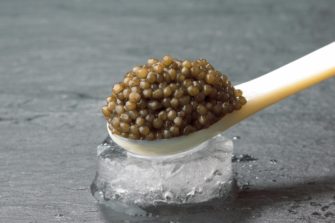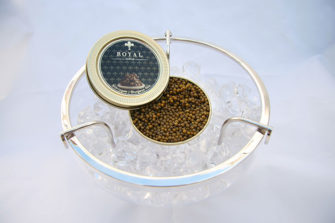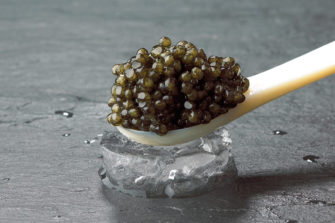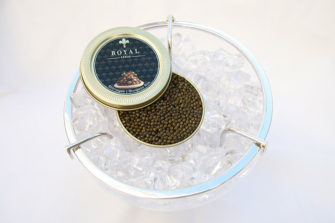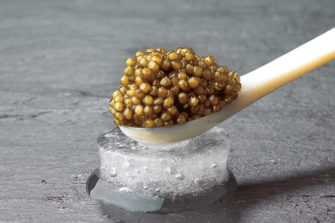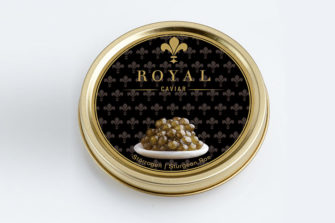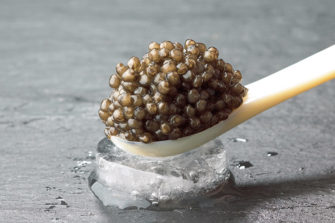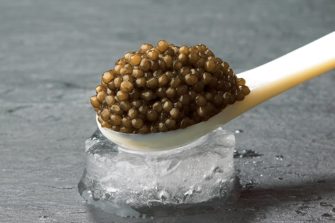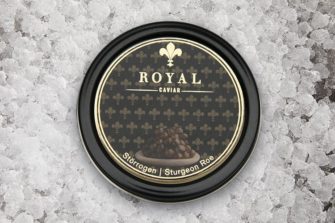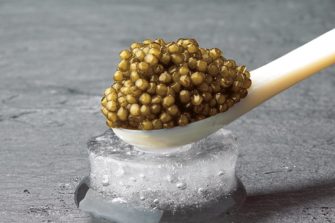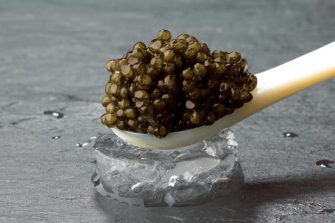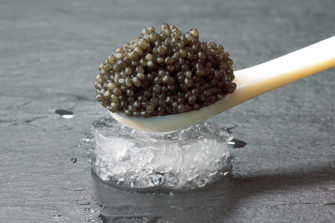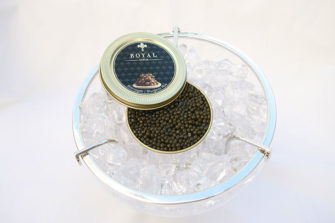Caviar – The most expensive delicacy in the world
Caviar is one of the few foods that pretty much everyone associates with luxury and exclusivity. The delicacy has long been an integral part of upscale gastronomy, and is still considered by most people to be a delicacy that one only treats oneself to one very special occasions. A speciality for real connoisseurs!
But how is it that caviar is in such high demand worldwide? What makes the black pearls so special? We have investigated these and other questions and have compiled the most important facts here. Enjoy reading!
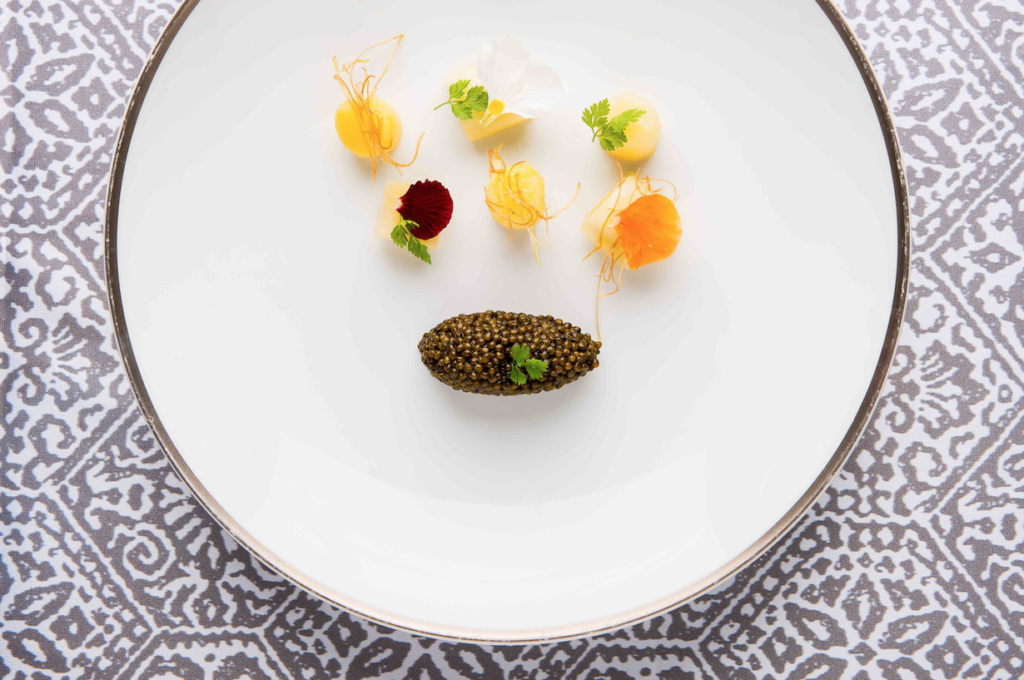
The history and naming of caviar
The word caviar is still unclear today, as there are several possible explanations as to where the word originated. However, two sources are frequently mentioned. One is its descent from the Khedives, an Iranian ethnic group that settled on the Caspian Sea. According to tradition, they called fish eggs cahv-jar, from which the word caviar later developed. Another theory is that the term comes from the Persian word khag-viar, which means “small black fish egg”.
In the 19th century, caviar came from Russia to Europe by sea. Initially still food for the poorer population, the black gold became increasingly popular and expensive. Especially in the USA, caviar experienced an enormous boom at the end of the 19th century. As a result, fish stocks declined rapidly, and white sturgeon fishing was completely banned in the USA in 1915. It was not until the 1950s that the law was relaxed and at least sport fishing for sturgeon was allowed again. Due to overfishing in the USA and Europe, sturgeon began to be caught in the Caspian Sea, which led to caviar production spreading to Russia and Iran. But here too, uncontrolled fishing and high demand had a negative impact on the population. Due to overfishing, sturgeon were on the verge of extinction more than 20 years ago. In 1998, the international community therefore adopted the CITES Convention, which bans the catch and trade of endangered sturgeon worldwide. Caviar as we know it today comes exclusively from aquacultures and is subject to strict labelling requirements.
Caviar production and trade
Just 20 years ago, caviar production from farms was still in its infancy. For one thing, there were far fewer aquaculture farms worldwide, and for another, the quality of caviar from farms was not yet comparable to that from wild stocks. In the meantime, the quality of caviar is so good that it hardly differs from the quality from wild stocks. And that makes the black pearls more and more popular. For example, production almost doubled from 2014 to 2019 to just under 500 tonnes per year. There are clear regulations for the trade in caviar worldwide. For example, every can must have a standardised label with information on the production site and the country of origin.
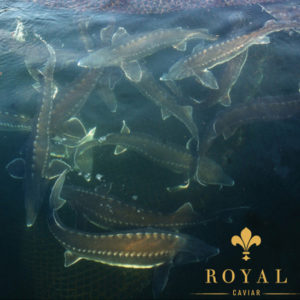
The shelf life and preservation of caviar
Caviar is a quickly perishable natural product. However, there are ways to extend its shelf life. One common method is to lightly salt fresh caviar. Caviar treated in this way is also called “malossol” (more information on this can be found in the next section).
The shelf life of caviar must be stated on the label of each can. In Germany, two labels are required, the best before date and the use by date. The best-before date (MHD) is a consumer notice that guarantees the edible consumption of a product until a certain date. Often the product can still be consumed after expiry. The use-by date, with which caviar is marked, is a consumption notice for perishable goods such as fish or meat. After the expiry date, consumption is strongly discouraged. For both the best-before date and the use-by date, the information is only valid on the condition that the prescribed storage of the respective product is observed.
In any case, caviar must be stored in a cool place! Our Royal Caviar can be kept unopened for at least six weeks if stored properly. However, this can vary depending on the variety. You will find a note on the shelf life on the label of each Royal Caviar tin. We always deliver our caviar in polystyrene boxes with ice accumulators to ensure the cold chain during transport. After opening a can, the caviar should be distorted in 1 to 2 days, otherwise eating it could have health consequences.
Learn more about the shelf life of caviar.
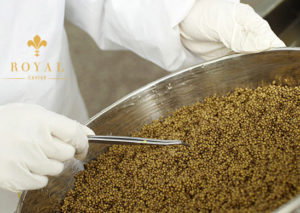
Malossol – A quality feature
This treatment was traditionally necessary to ensure a better shelf life of the sturgeon roe. In the process, the salt content varied depending on the season: in the winter months, caviar is salted less than in the summer due to the cooler temperatures anyway. In addition to preservation, the malossol treatment also has an effect on the flavour and colour of the caviar. As the salt removes liquid from the roe, the grains become darker and their flavours intensified. The caviar thus receives a flavour enhancement. The term “malossol” inevitably comes up in connection with caviar. However, this is not a type of caviar or a designation of origin. Rather, malossol is a statement about the preparation. The word malossol comes from Russian and literally means “lightly/weakly salted”. Malossol caviar is therefore sturgeon roe that is only minimally salted, i.e. has a salt content of 2.8-4 %.
The correct storage of caviar
Correct handling, packaging, proper storage and, in particular, adherence to the cold chain are the be-all and end-all for ensuring the freshness of the precious sturgeon roe. The ideal storage temperature is between -2 °C and 0 °C. This temperature range must be strictly adhered to, because already at a temperature below -4 °C the roes lose their taste and change their consistency. Warmer temperatures, i.e. above 4 °C, are also already damaging and make the caviar perishable. Particular caution is therefore required with tins that have already been opened. These should definitely be distorted within a few days! Caviar is also not suitable for freezing, as the roe bursts when thawed and this has a negative effect on both the taste and the consistency.
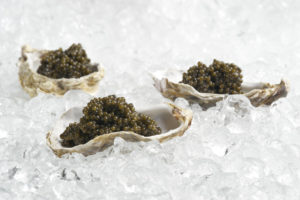
Freshness characteristics of caviar
Caviar is a natural product that reacts to environmental influences. Thus, the characteristics of caviar change in the course of production and transport. But how do you actually recognise the quality of good caviar?
How fresh caviar is can be determined by various characteristics, because not only the colour of the sturgeon roe is a sign of quality. The smell is particularly important. Fishy or metallic scents are a clear alarm signal for poor quality and a spoilage process that has already begun.
The fish eggs should also have a delicate, slightly shimmering surface structure. When opening the caviar tin, the grains must not stick to the lid under any circumstances, but should lie as loosely as possible on top of each other.
To make sure that the caviar is really fresh, you can spread a small portion of the roe on the back of your hand and taste it. Only if there is no smell and no oil film left on the palm of your hand is this evidence of freshness.

Caviar season
Originally, the season for wild caviar is from November to January. However, since the trade in wild caviar has been banned worldwide for years, the season no longer plays a role in the availability of caviar. This is because farmed caviar can be produced regardless of the season and fresh caviar is therefore available all year round.
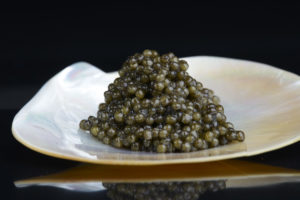
Caviar prices
Caviar is one of the most expensive foods. The prices for caviar can vary worldwide. Especially when caviar was still obtained from wild stocks and not from aquacultures, this had a drastic effect on price developments. However, not only the quantity available on the market, but also the variety, the effort in production and above all the quality are important price factors. Good caviar is currently available from around €1,000 upwards per kilogram.
The taste of caviar
Caviar never tastes the same, as the flavour depends on various factors such as the fish, the sturgeon variety, the region, and the maturing process. There are varieties with a nutty taste, others with a fine, spicy flavour and still others with a creamy to creamy taste. Caviar varieties also differ from one another in their aromatic intensity, ranging from mild to very strong.
The preparation and consumption of caviar
Caviar is traditionally eaten with a mother-of-pearl spoon so as not to distort the natural flavour. Silver or metal spoons, on the other hand, are less suitable for eating caviar, as they produce a metallic taste due to oxidation with the pearls.
Caviar is often served on ice. There are no limits to the combination with other foods. Whether together with blinis, on toast, with jacket potatoes or with a glass of champagne: Caviar tastes delicious in many combinations.
Are you looking for inspiration for caviar dishes? On royalcaviar.de, we have put together six very different recipe ideas from famous star chefs for you to try.
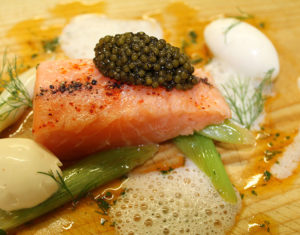
The nutritional values of caviar
Caviar contains a whole range of valuable minerals and vitamins such as vitamin D, E, B2, B12 as well as biotin and iodine. With 26g of protein per 100g, caviar is also a good source of protein. 100g of sturgeon caviar have about 259 kcal. So, eating caviar is quite healthy, but should not be consumed in excessive amounts due to the salt content and cholesterol. Read more details about ingredients and nutritional values of caviar.
Caviar alternatives
One thing real caviar always is: expensive! Not everyone can afford it, of course. Others simply don’t want to eat fish products. That’s why there is now a wide range of caviar alternatives.
Salmon caviar is probably the best-known substitute. The characteristic feature is the orange or red colour of the roe.
German caviar is also a well-known substitute. This is roe from the lumpfish. This is a fish species that occurs mainly in the North Atlantic. The fish eggs of the lumpfish are pink to yellow, and the colour of the roe only changes to a black tone during processing. Roe is also taken from other fish, such as pike, cod or herring, and processed into caviar substitute.
In the meantime, vegan versions made from algae or agar-agar are also available on the market.
Caviar facts
Did you know that …
… there are 27 species of sturgeon found only in the Northern Hemisphere of the earth?
Sturgeons are mainly found in the Caspian Sea, the Black Sea and the Sea of Azov.
… Europe is the biggest market for caviar?
Most people probably assume that caviar finds most of its customers in the Asian region, because of Russia and China, but far from it. Most caviar is sold in Europe. In 2014, 150 tonnes were sold in Europe and Russia together. Only then followed China, with a consumption of 54 tonnes per year.
… wild caviar is banned?
The sturgeon has been an endangered species for more than 20 years. To prevent this, the international community of states imposed a worldwide ban on fishing a few years ago. Only farmed caviar from aquacultures is currently legal.
… caviar is the second most important export commodity?
And that is in Iran. Hard to believe, but true! Right after oil, caviar is Iran’s second-largest export commodity.
… only ten percent of all sturgeon caviars are black?
The colour of sevruga has ensured that caviar is black in most people’s minds, although in reality only ten per cent of all sturgeon caviar is black. Much more often, real caviar is grey.
… caviar was offered as a snack in bars in the 19th century?
And that was in the USA. Caviar was mass-produced back then and was so popular that you could get the black gold as a snack with your beer in pretty much every pub, much like peanuts today.
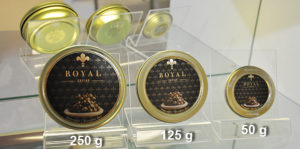
The Royal Caviar Online Shop
Would you like to enjoy high-quality caviar? Feel free to drop by our Royal Caviar Onlineshop. We ourselves have been caviar wholesalers for over 20 years and source our varieties directly from the breeding farms. There, the fish live in large lakes that imitate as natural a habitat as possible. On site, our caviar masters constantly check the quality of the roe to guarantee the best possible quality. Our caviar is a special cross between Beluga and Asetra caviar, available at an unbeatable price-performance ratio.
In our caviar varieties Royal Beluga you can obviously buy Royal Premium, Royal Select, Imperial Caviar and Ossetra Caviar from 50 gram tins to 1.75 kilogram tins. In addition, you will also find exquisite truffle varieties, as well as Norwegian salmon. Furthermore, our product range includes tasting sets consisting of different types of caviar as well as a gourmet set, which makes an excellent gift.
We look forward to your visit!
To the Onlineshop
 DE
DE RU
RU